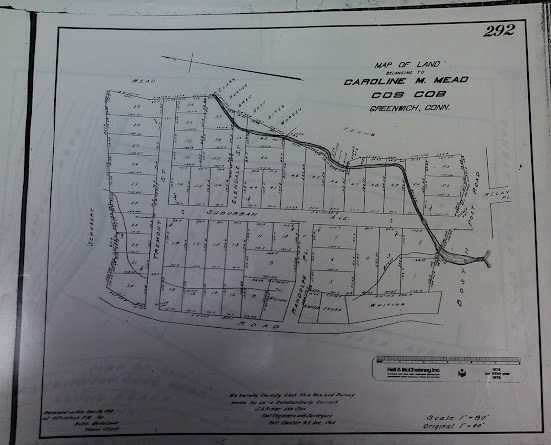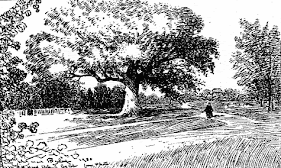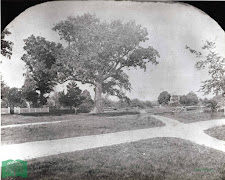Source: Greenwich News and Graphic, by Erwin Edwards. February 11, 1921. Page 4 and 10.
Ten Acres: Every resident of the Town but the stranger, knows where Ten Acres is. (Note: Ten Acres is now the campus of Greenwich High School off East Putnam Avenue and Hillside Road).
And why shouldn't every resident of the Town but the stranger, knows where Ten Acres is located, that is if a historic plot of land, which is as old as Horseneck, counts for anything in the mind of that resident?
Historic, yes, as historic as Put's Hill; perhaps not so widely known, but the two are always associated together by Greenwich people whenever either is mentioned, for both are connected with the history and life of Greenwich, and admin each other.
It was across Ten Acres that general Putnam sped after his ride down the steep, now named in his honor, it being a short cut over the meadow to the main road leading to Fort Putnam, three miles away, where Putnam was hastening for reinforcements, after Tryon's raid on Greenwich.
Near the Boston Post road, or as it was called in those days the King's Highway, and on Ten Acres, was the home of a patriot, one who fought in the revolutionary war and attained high rank and one who did much for Greenwich -Major-General Ebenezer Mead.
The house which he occupied, and in the doorway of which he stood when General Putnam Dashed down the hill and cut across the meadow, is still standing and is just beyond the foot of the steep.
A few years ago there was uncovered at Ten Acres not far from the house and to the west of it, a gravestone which marked the last resting place of General Mead.
How it was uncovered came about in this way: There came to Greenwich some years ago from the west a man whose boyhood days had been spent in Greenwich, by the name of James R. Mead.
After making some inquiries he learned that General Mead was buried at Ten Acres, a fact which he knew, but the exact spot he didn't know.
But he found someone who seemed to know where the grave was supposed to be, and this information was imparted to him.
he gave instructions to a responsible man to find out if the grave of General Mead could positively be proved to be there. Carefully the underbrush, the earth and the grass, which had accumulated in long years was removed, time having leveled the original mound.
Soon a gravestone was unearthed, which lay flat on the ground, having been beaten to earth by winds and storms. It could be seen that it was cracked across its center width. It was carefully lifted out of its resting place and placed on the ground nearby.
Deftly the clinging dirt and moss was brushed off, and traces were then disclosed of the indentures of an inscription.
Still more carefully removing the discolorations and the moss, which had adhered to it, then it was that the marks on it were plainly revealed, and the inscription was easily deciphered and read:
Maj-General
EBENEZER MEAD
died Feb. 7, 1818
Yes, that was the grave of General Mead. There was no doubt about it, the gravestone was the proof. The long neglected and almost obliterated resting place of this noted General, this Connecticut soldier, and Greenwich patriot had been found.
The Ebenezer Mead gravestone, relocated many years ago to the cemetery in Christ Church Greenwich.
There was other wording on this brown gravestone, but only the name and the date could be made out.
The ground was smoothed over and the spot was left undisturbed otherwise. The monument was not taken away, and it is there today, or was, a short time ago, or it may be leaning alongside the near-by stonewall where it was placed.
It was the custom in colonial days, and later, to bury th owner of a farm or an estate, on the premises, usually in the orchard, in a lot back of the house, or by the road-side near the dwelling. And that is how it happened that the grave of General Mead was in Ten Acres, not far from his dwelling.
Just beyond the meadow where this grave is, or rather at the top of Put's Hill, is the large boulder, or monument, placed there in memory of General Putnam and marking the place where he started on his daring ride.
All which explains how that immediate locality has become historic, associated as it is, with great men and colonial life and revolutionary war days.
How Ten Acres came by its name would naturally suggest itself to most anyone. It is a large, level meadow, round in contour and contains just that number of acres, and there is not a tree on the field.
Just north of Ten Acres, West Brothers Brook comes tumbling down over the rocks, at such descent, and in such rapid current, that the water, dashing against the strong obstructions, is churning into foam, which suggested the name, Butter Milk Falls, a name as old as Ten Acres.
West Brothers Brook courses down through the meadow, but originally went its own way. years ago, however, a deep ditch was cut through the center of the field, and the water now flows in this ne channel, continuing its run until it meets its brother, East Brothers Brook, at the side of the Boston Post road, but a short distance beyond.
In the winter, Ten Acres becomes an ice pond, by means of a dam which causes the meadow to be flooded with water.
For years and years, a hundred years, Ten Acres has been a pleasure ground in the winter time. A popular skating pond, known far beyond the confines of Greenwich, and today it is more popular than ever as a pond to indulge in that pastime.
Though Ten Acres may some day be more exclusive than it is under its present owner, for he has never put up a "no trespass" sign, nor does he intend to, but if the public is ever disbarred from it, it will always have its historic associations which never can be taken away from it as long as the history of Greenwich remains.





















